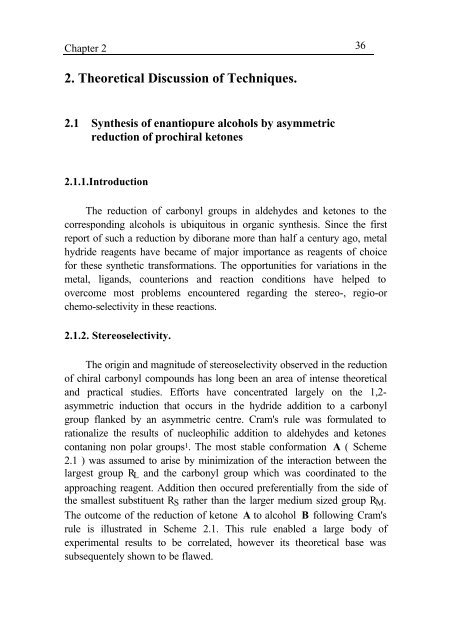Advances in the stereoselective synthesis of antifungal agents and ...
Advances in the stereoselective synthesis of antifungal agents and ...
Advances in the stereoselective synthesis of antifungal agents and ...
Create successful ePaper yourself
Turn your PDF publications into a flip-book with our unique Google optimized e-Paper software.
Chapter 2 362. Theoretical Discussion <strong>of</strong> Techniques.2.1 Syn<strong>the</strong>sis <strong>of</strong> enantiopure alcohols by asymmetricreduction <strong>of</strong> prochiral ketones2.1.1.IntroductionThe reduction <strong>of</strong> carbonyl groups <strong>in</strong> aldehydes <strong>and</strong> ketones to <strong>the</strong>correspond<strong>in</strong>g alcohols is ubiquitous <strong>in</strong> organic syn<strong>the</strong>sis. S<strong>in</strong>ce <strong>the</strong> firstreport <strong>of</strong> such a reduction by diborane more than half a century ago, metalhydride re<strong>agents</strong> have became <strong>of</strong> major importance as re<strong>agents</strong> <strong>of</strong> choicefor <strong>the</strong>se syn<strong>the</strong>tic transformations. The opportunities for variations <strong>in</strong> <strong>the</strong>metal, lig<strong>and</strong>s, counterions <strong>and</strong> reaction conditions have helped toovercome most problems encountered regard<strong>in</strong>g <strong>the</strong> stereo-, regio-orchemo-selectivity <strong>in</strong> <strong>the</strong>se reactions.2.1.2. Stereoselectivity.The orig<strong>in</strong> <strong>and</strong> magnitude <strong>of</strong> stereoselectivity observed <strong>in</strong> <strong>the</strong> reduction<strong>of</strong> chiral carbonyl compounds has long been an area <strong>of</strong> <strong>in</strong>tense <strong>the</strong>oretical<strong>and</strong> practical studies. Efforts have concentrated largely on <strong>the</strong> 1,2-asymmetric <strong>in</strong>duction that occurs <strong>in</strong> <strong>the</strong> hydride addition to a carbonylgroup flanked by an asymmetric centre. Cram's rule was formulated torationalize <strong>the</strong> results <strong>of</strong> nucleophilic addition to aldehydes <strong>and</strong> ketonescontan<strong>in</strong>g non polar groups 1 . The most stable conformation A ( Scheme2.1 ) was assumed to arise by m<strong>in</strong>imization <strong>of</strong> <strong>the</strong> <strong>in</strong>teraction between <strong>the</strong>largest group R L <strong>and</strong> <strong>the</strong> carbonyl group which was coord<strong>in</strong>ated to <strong>the</strong>approach<strong>in</strong>g reagent. Addition <strong>the</strong>n occured preferentially from <strong>the</strong> side <strong>of</strong><strong>the</strong> smallest substituent R S ra<strong>the</strong>r than <strong>the</strong> larger medium sized group R M .The outcome <strong>of</strong> <strong>the</strong> reduction <strong>of</strong> ketone A to alcohol B follow<strong>in</strong>g Cram'srule is illustrated <strong>in</strong> Scheme 2.1. This rule enabled a large body <strong>of</strong>experimental results to be correlated, however its <strong>the</strong>oretical base wassubsequentely shown to be flawed.















